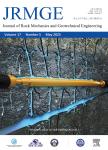版权所有:内蒙古大学图书馆 技术提供:维普资讯• 智图
内蒙古自治区呼和浩特市赛罕区大学西街235号 邮编: 010021

作者机构:Department of Earth Sciences Faculty of Science The University of Hong Kong Hong Kong SAR China
出 版 物:《Journal of Rock Mechanics and Geotechnical Engineering》
年 卷 期:2025年
主 题:Triaxial compression Creep-fatigue interaction Rock salt Discrete element method Particle flow code
摘 要:This study investigates the creep-fatigue interaction characteristics of rock salt under triaxial conditions. Utilizing PFC 2D to conduct creep-fatigue simulation tests on rock salt under various confining pressures and stress intervals, the research systematically analyzes the triaxial stress-strain response, creep-fatigue life and interaction, crack propagation, and energy dissipation characteristics. The Burger’s and Linear Parallel Bond (LPB) models are employed to concurrently represent time-dependent and damage behavior. The results indicate that the hysteresis loops for the axial stress-strain curves of salt specimens in triaxial creep-fatigue tests are initially dense but become sparse as fracture approaches. An increase in confining pressure results in a higher number of microcracks, increased fracture strain, extended creep-fatigue life, and greater cumulative dissipated energy upon fracture. The creep-fatigue life is shorter than the pure fatigue life at each confining pressure, highlighting a detrimental interaction effect between creep damage and fatigue damage under triaxial conditions. The variation in confining pressure has a minimal impact on the creep or fatigue fraction for the salt specimens under these conditions. Fractured salt specimens under low confining pressure exhibit penetrating inclined cracks surrounded by numerous microcracks, whereas significant dilatancy is observed under high confining pressure. The findings of this study contribute to a scientifically grounded approach for designing energy storage salt caverns, with an emphasis on long-term stability. Additionally, these findings provide a valuable reference for investigating the meso-mechanical characteristics of other rock types, particularly in relation to triaxial creep-fatigue behavior.